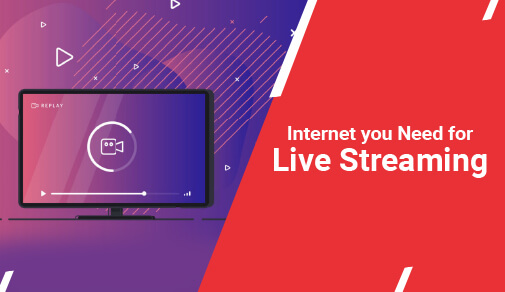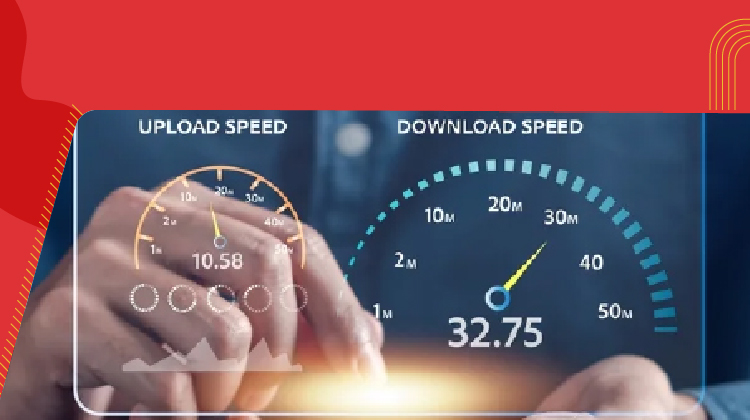What Internet Speed You Need For Live Streaming?
Wednesday, Mar 31, 2021 · 3 minutes


LIVE STREAMING
Wednesday, Mar 31, 2021 · 3 minutes
Let's cover some basics before we get started. There are two types of data transfers on the Internet—uploads and downloads.
Uploading is the process of sending data to the Internet from your local device. Posting an image on Facebook, sending an email, and broadcasting live are all examples of content uploading.
Like download speeds, upload speeds depend on the size and bandwidth of the video file. For live streaming, the size of the video file depends on the quality of the content. We recommend the speed of upload of:
We recommend a minimum upload speed of 100 Mbps for live streaming. On most platforms, this will give you a slight buffer to account for upload speed fluctuations. Different streaming platforms have different video quality requirements. Some are optimised so that you can broadcast low-resolution video from your cell phone whenever you want, while others try to make it possible for viewers to tune to TV-quality streams.
| Resolution | Min. upload speed |
|---|---|
| 720p (30 fps) | 3 Mbps |
| 720p (60 fps) | 4.5 Mbps |
| 1080p (30 fps) | 4.5 Mbps |
| 1080p (60 fps) | 6 Mbps |
| Resolution | Min. upload speed |
|---|---|
| 720p (30 fps) | 4 Mbps |
| Resolution | Min. upload speed |
|---|---|
| 240p | 0.3 Mbps |
| 480p | 0.4 Mbps |
| 720p (60 fps) | 2.2 Mbps |
| 1080p (60 fps) | 3 Mbps |
| 1440p (60 fps) | 9 Mbps |
| 4K/2160p (30 fps) | 13 Mbps |
| 4K/2160p (60 fps) | 20 Mbps |
##BlogVASBanner##
There could be many factors impacting internet speed and we have outlined them here for you.
ACT Fibernet delivers internet service to your home through fibernet. However, DSL and lower broadband services are usually wired using copper. Most high-speed broadband services deliver internet via a hybrid fiber and copper network. ACT Fibernet provides the internet directly to your home using a 100% fiber network.
Many factors inside your home can affect the rate at which you send or receive data over the internet. These include:
You can connect your home internet through a wired ethernet cable or a wireless connection. Wired cable connections use Cat5e or Cat6 wires connected to the ethernet port on your wall or router. Wired connections give consistent performance and speed. Wireless connections provide you flexibility to move through your home, but they are not as fast as a wired connection. You get the best Wi-Fi signal closest to your router, and, with fewer devices running.
All devices have a maximum internet speed they can reach. However, that internet speed may not be as fast as your internet service plan. For example, if your older laptop or mobile only supports 20Mbps and you have 1Gbps internet plan, your laptop will never be able to reach more than 20 Mbps internet speed.
In a lot of cases, TV and the internet connections in your home come in through the same cable. Using both services at the same time takes up more available bandwidth and can take a toll on your internet download speeds. For example, watching multiple HD shows at the same time as very high data consumption internet usage, such as downloading a complete HD movie file on your computer, may lead to lower internet speeds as compared with internet speeds when no other uses are happening on your home internet network.
80

The New Social: How High-Speed Internet is Redefining 'Quality Time' with Friends and Family
Read more292

How ACT SmartWi-Fi is Redefining Home Internet in 2025: The Age of AI-Powered Seamless Connectivity
Read more125

From Bandwidth to Intelligence: How AI Is Redefining Business Demands from ISPs
Read more
A referral link has been sent to your friend.
Once your friend completes their installation, you'll receive a notification about a 25% discount on your next bill
![]() Please wait while we redirect you
Please wait while we redirect you

![]() One of our representatives will reach out to you shortly
One of our representatives will reach out to you shortly

One of our representatives will reach out to your shortly
![]() Please wait while we redirect you
Please wait while we redirect you

Please enter your registered phone number to proceed

Please enter correct OTP to proceed


Dear customer you are successfully subscribed
Please wait while we redirect you

Your ACT Shield subscription has been successfully deactivated

Dear user, Your account doesn't have an active subscription

Dear customer Entertainment pack is already activated.
Please wait while we redirect you